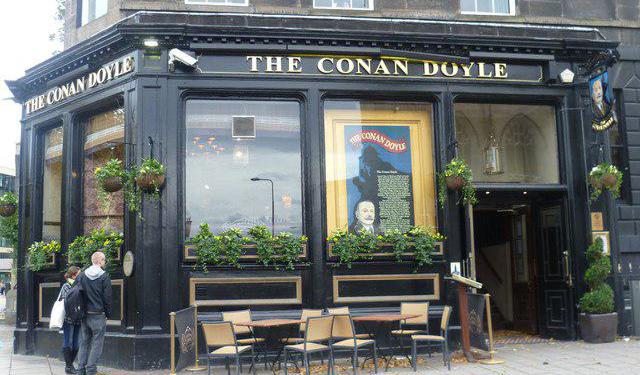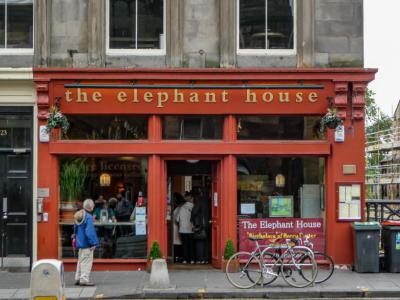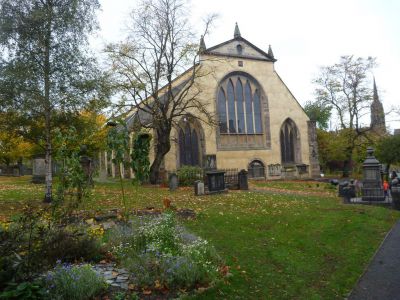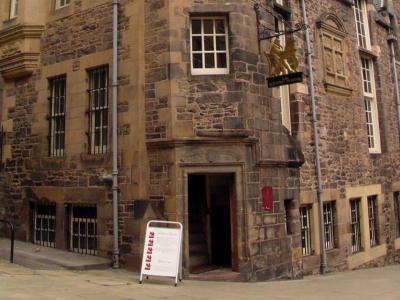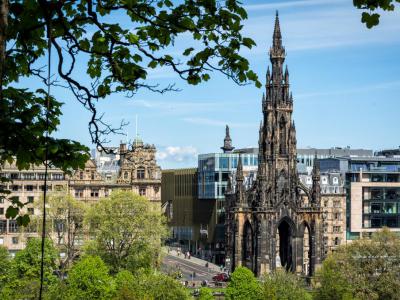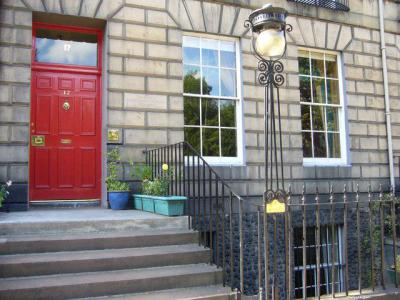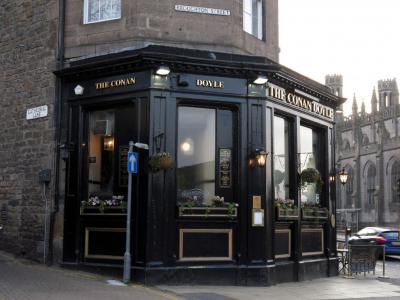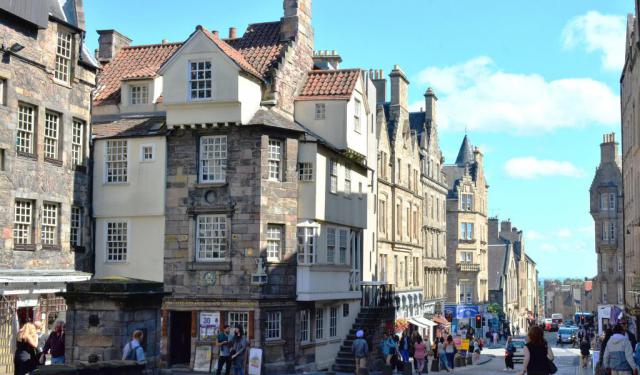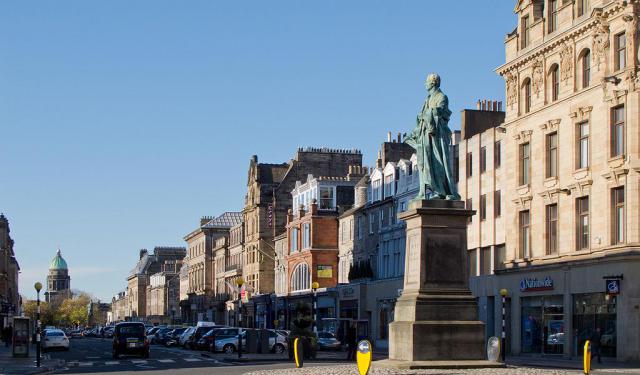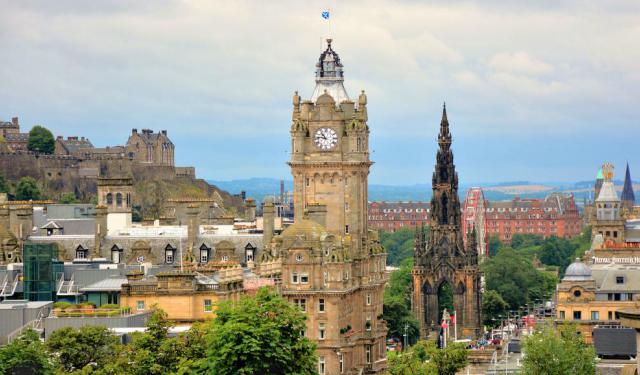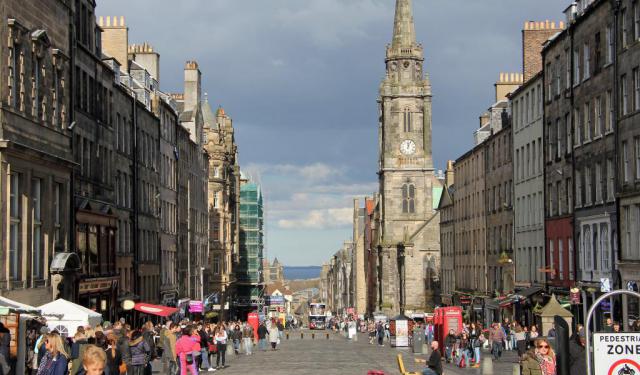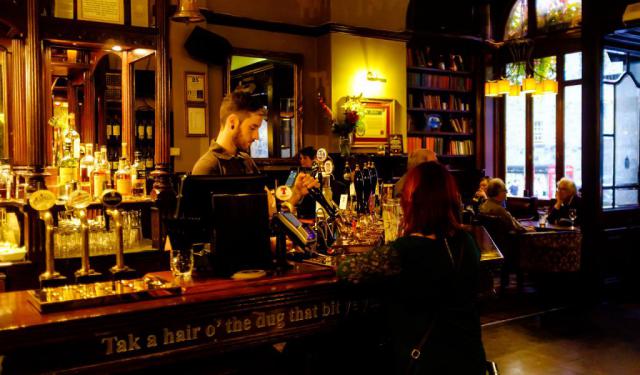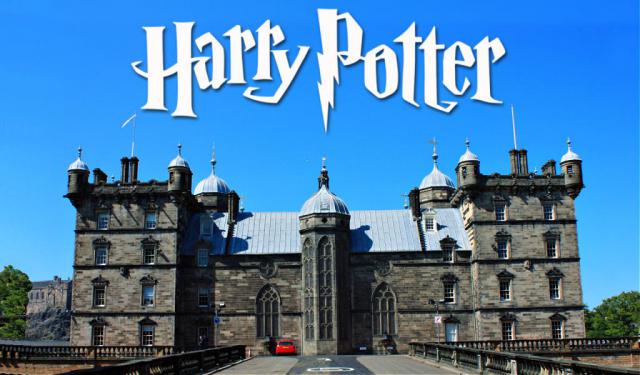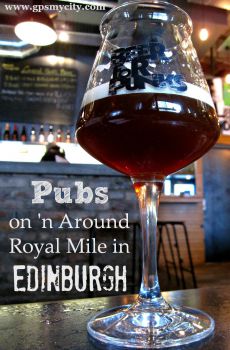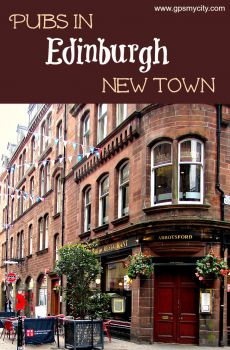Literary Landmarks Tour (Self Guided), Edinburgh
For centuries, Edinburgh has been home to numerous writers. The likes of Robert Burns, Robert Louis Stevenson, and JK Rowling, just to name a few, have given pride to this city. Fortunately, the tradition doesn't seem to die out any time soon, as Edinburgh keeps producing more and more authors and literary heroes in whose footsteps people still wish to tread.
Naturally, there is a wealth of iconic landmarks in Edinburgh that left an indelible mark on the world of literature. These locations offer a glimpse into the capital's literary history and its influence on renowned authors.
The Elephant House, a cozy café nestled in the heart of Edinburgh, is famous as the birthplace of JK Rowling's Harry Potter series. Today, this charming spot has become a pilgrimage site for fans of the wizarding world.
Another must-visit site for Harry Potter fans is Greyfriars Church. Hidden behind the Elephant House Café, this historic church's graveyard is said to have inspired (at least in terms of names) some of the book's characters, like Tom Riddle (Lord Voldemort), derived from the grave of Thomas Riddell here.
The Writers' Museum and Makar's Court is a treasure trove for lovers of Scottish literature. Located on the Royal Mile, this museum honors Scotland's literary greats, like Robert Burns, Sir Walter Scott, and Robert Louis Stevenson. Makar's Court, just outside the museum, features inscriptions of quotes from various Scottish men of letters.
The Scott Monument, a towering Gothic structure dedicated to Sir Walter Scott, offers breathtaking panoramic views of the city. Scott's prolific works, including "Waverley" and "Ivanhoe," continue to captivate readers worldwide to this day.
Robert Stevenson's Childhood Home, the birthplace of the famous author of "Treasure Island" and "Doctor Jekyll and Mister Hyde," provides a glimpse into his early life and inspiration for his adventurous tales.
For fans of detective fiction, The Conan Doyle Pub pays homage to the creator of Sherlock Holmes, Sir Arthur Conan Doyle. Enjoy a pint of ale and immerse yourself in the world of the brilliant detective.
A seasoned bookworm or simply one curious about the city's literary heritage will find these sites equally interesting. So, embark on this literary pilgrimage, explore the stories that shaped Edinburgh, and be inspired by the words of the great writers who once graced these locations with their presence.
Naturally, there is a wealth of iconic landmarks in Edinburgh that left an indelible mark on the world of literature. These locations offer a glimpse into the capital's literary history and its influence on renowned authors.
The Elephant House, a cozy café nestled in the heart of Edinburgh, is famous as the birthplace of JK Rowling's Harry Potter series. Today, this charming spot has become a pilgrimage site for fans of the wizarding world.
Another must-visit site for Harry Potter fans is Greyfriars Church. Hidden behind the Elephant House Café, this historic church's graveyard is said to have inspired (at least in terms of names) some of the book's characters, like Tom Riddle (Lord Voldemort), derived from the grave of Thomas Riddell here.
The Writers' Museum and Makar's Court is a treasure trove for lovers of Scottish literature. Located on the Royal Mile, this museum honors Scotland's literary greats, like Robert Burns, Sir Walter Scott, and Robert Louis Stevenson. Makar's Court, just outside the museum, features inscriptions of quotes from various Scottish men of letters.
The Scott Monument, a towering Gothic structure dedicated to Sir Walter Scott, offers breathtaking panoramic views of the city. Scott's prolific works, including "Waverley" and "Ivanhoe," continue to captivate readers worldwide to this day.
Robert Stevenson's Childhood Home, the birthplace of the famous author of "Treasure Island" and "Doctor Jekyll and Mister Hyde," provides a glimpse into his early life and inspiration for his adventurous tales.
For fans of detective fiction, The Conan Doyle Pub pays homage to the creator of Sherlock Holmes, Sir Arthur Conan Doyle. Enjoy a pint of ale and immerse yourself in the world of the brilliant detective.
A seasoned bookworm or simply one curious about the city's literary heritage will find these sites equally interesting. So, embark on this literary pilgrimage, explore the stories that shaped Edinburgh, and be inspired by the words of the great writers who once graced these locations with their presence.
How it works: Download the app "GPSmyCity: Walks in 1K+ Cities" from Apple App Store or Google Play Store to your mobile phone or tablet. The app turns your mobile device into a personal tour guide and its built-in GPS navigation functions guide you from one tour stop to next. The app works offline, so no data plan is needed when traveling abroad.
Literary Landmarks Tour Map
Guide Name: Literary Landmarks Tour
Guide Location: Scotland » Edinburgh (See other walking tours in Edinburgh)
Guide Type: Self-guided Walking Tour (Sightseeing)
# of Attractions: 6
Tour Duration: 1 Hour(s)
Travel Distance: 2.9 Km or 1.8 Miles
Author: Helen
Sight(s) Featured in This Guide:
Guide Location: Scotland » Edinburgh (See other walking tours in Edinburgh)
Guide Type: Self-guided Walking Tour (Sightseeing)
# of Attractions: 6
Tour Duration: 1 Hour(s)
Travel Distance: 2.9 Km or 1.8 Miles
Author: Helen
Sight(s) Featured in This Guide:
- The Elephant House
- Greyfriars Church
- Writers' Museum & Makar’s Court
- Scott Monument
- Robert Stevenson's Childhood Home
- The Conan Doyle Pub
1) The Elephant House
If you’ve ever wanted to sip a cappuccino where magic once brewed-quite literally-then The Elephant House might just be your pilgrimage stop. Open since 1995, this unassuming café earned worldwide fame not just for its tea and coffee (which are excellent, by the way), but for serving as a launchpad for a certain bespectacled boy wizard. Yes, J.K. Rowling once holed up in the back room here, penning early chapters of Harry Potter while eyeing up the brooding silhouette of Edinburgh Castle. Talk about dramatic inspiration...
But Rowling wasn’t the only literary mind to haunt these elephant-adorned halls. Other patrons like Ian Rankin, the mastermind behind the gritty Rebus detective novels, and Alexander McCall Smith, author of The No.1 Ladies' Detective Agency and 44 Scotland Street fame, have also warmed the seats here. Apparently, there’s something about the mix of caffeine, castle views, and atmospheric chatter that gets the creative juices flowing.
So, whether you’re nursing dreams of becoming the next literary sensation or just need a sturdy espresso before wandering into Edinburgh’s medieval maze-drop by The Elephant House. Who knows? That scribble on your napkin might just be the next bestseller...
But Rowling wasn’t the only literary mind to haunt these elephant-adorned halls. Other patrons like Ian Rankin, the mastermind behind the gritty Rebus detective novels, and Alexander McCall Smith, author of The No.1 Ladies' Detective Agency and 44 Scotland Street fame, have also warmed the seats here. Apparently, there’s something about the mix of caffeine, castle views, and atmospheric chatter that gets the creative juices flowing.
So, whether you’re nursing dreams of becoming the next literary sensation or just need a sturdy espresso before wandering into Edinburgh’s medieval maze-drop by The Elephant House. Who knows? That scribble on your napkin might just be the next bestseller...
2) Greyfriars Church
Edinburgh makes things easy for history buffs: just follow the soot-streaked stones of the Old Town and you’ll trip over ancient buildings in no time. One such relic is Greyfriars Church-an architectural overachiever that’s been around since the early 1600s and still manages to steal the show.
Work on the church began in 1602, and by 1630, it was officially consecrated, rising from the ruins of an abandoned Franciscan monastery and becoming one of the oldest buildings in the Old Town. Its name is a fashion nod to the original residents-monks in grey robes, otherwise known as the “Grey Friars.” Simple branding, eternal legacy...
In 1718, someone got the bright idea to divide the church with a wall-Old Greyfriars on one side, New Greyfriars on the other-because heaven forbid the Covenanters and Roman Catholics share pew space. Then, in 1845, the roof caught fire (presumably not from divine wrath), destroying much of the interior.
When the church was restored in the mid-19th century, they added stained-glass windows. Beautiful they were? Yes. Controversial? Also, yes-for it was the first time that such windows appeared in a Presbyterian church, and it caused a bit of a scandal. A little later, an organ was added, and once again the purists “clutched their pearls.” In 1929, they finally took down the dividing wall and made peace… at least architecturally.
Oh, and the adjoining graveyard-it's said to be haunted by the ghost of one “Bloody” George Mackenzie. A Lord Advocate responsible for the persecution of the Covenanters, his reputation is as bruised as his victims. They say that if he touches you, you’ll feel it-physically!-left with cuts and bruises... Sleep tight!
Still, nowadays, Greyfriars also doubles as an event venue and low-key fashion runway. It hosts exhibitions, lectures, and drama productions-all performed under those once-scandalous stained glass windows. The onsite museum showcases artifacts found in the area and recounts a comprehensive history of the Covenanters.
And for the wizarding crowd-just behind the Elephant House Café lies Greyfriars Kirkyard, where literary pilgrims flock to pay homage to tombstones that may-or may not-have inspired J.K. Rowling. Among those are Thomas Riddell (ring a bell, Voldemort fans?), Robert Potter, William McGonagall, and even names like Elizabeth Moodie and Margaret Louisa Scrymgeour Wedderburn, suspiciously close to Mad-Eye Moody and Rufus Scrimgeour (the Minister of Magic in the final Harry Potter book). As of August 2019, you can buy a handy Harry Potter-themed gravestone map; the proceeds from sales go toward graveyard upkeep-and probably a bit of Muggle curiosity management, too.
Also, visible from here is George Heriots School, reportedly the template for fictional Hogwarts...
Work on the church began in 1602, and by 1630, it was officially consecrated, rising from the ruins of an abandoned Franciscan monastery and becoming one of the oldest buildings in the Old Town. Its name is a fashion nod to the original residents-monks in grey robes, otherwise known as the “Grey Friars.” Simple branding, eternal legacy...
In 1718, someone got the bright idea to divide the church with a wall-Old Greyfriars on one side, New Greyfriars on the other-because heaven forbid the Covenanters and Roman Catholics share pew space. Then, in 1845, the roof caught fire (presumably not from divine wrath), destroying much of the interior.
When the church was restored in the mid-19th century, they added stained-glass windows. Beautiful they were? Yes. Controversial? Also, yes-for it was the first time that such windows appeared in a Presbyterian church, and it caused a bit of a scandal. A little later, an organ was added, and once again the purists “clutched their pearls.” In 1929, they finally took down the dividing wall and made peace… at least architecturally.
Oh, and the adjoining graveyard-it's said to be haunted by the ghost of one “Bloody” George Mackenzie. A Lord Advocate responsible for the persecution of the Covenanters, his reputation is as bruised as his victims. They say that if he touches you, you’ll feel it-physically!-left with cuts and bruises... Sleep tight!
Still, nowadays, Greyfriars also doubles as an event venue and low-key fashion runway. It hosts exhibitions, lectures, and drama productions-all performed under those once-scandalous stained glass windows. The onsite museum showcases artifacts found in the area and recounts a comprehensive history of the Covenanters.
And for the wizarding crowd-just behind the Elephant House Café lies Greyfriars Kirkyard, where literary pilgrims flock to pay homage to tombstones that may-or may not-have inspired J.K. Rowling. Among those are Thomas Riddell (ring a bell, Voldemort fans?), Robert Potter, William McGonagall, and even names like Elizabeth Moodie and Margaret Louisa Scrymgeour Wedderburn, suspiciously close to Mad-Eye Moody and Rufus Scrimgeour (the Minister of Magic in the final Harry Potter book). As of August 2019, you can buy a handy Harry Potter-themed gravestone map; the proceeds from sales go toward graveyard upkeep-and probably a bit of Muggle curiosity management, too.
Also, visible from here is George Heriots School, reportedly the template for fictional Hogwarts...
3) Writers' Museum & Makar’s Court
Many a people dream of being successful authors with the riches and acclaim that go with the job. A visit to the Writer’s Museum on the Mound probably won’t help anyone on this way, but it will certainly give a great insight into some of Scotland’s most distinguished writers, so you shouldn’t miss visiting it.
You will find the museum in the Lady Stair’s House in the Close of the same name. The house was built in 1622 and was bought by the Dowager Countess of Stair in the late 18th century. Her descendants donated the property to the city of Edinburgh in 1907 on the premise that they use it for a museum of some sort.
Subsequently, they turned it into a museum dedicated to Robert Burns, Sir Walter Scott, and Robert Louis Stevenson, showcasing mementoes of these and other Scottish writers. The house is beautifully decorated in clear colours and gives visitors the feeling of stepping back in time.
The museum's collection features primarily the personal items of these three great writers, including a plaster cast of Robert Burns’ skull, Sir Walter Scott’s wooden rocking horse, a book won by Robert Louis Stevenson when he was at school, and more.
You will see Scott’s dining room, taken from his house and lovingly recreated here, along with his chessboard and the original printing press where his Waverley novels were printed. There is also a scale model of the Scott Monument.
On Robert Burns’ writing desk, you will find manuscripts and rough copies of his works, with mistakes neatly crossed out and jottings in the margins of the pages. Also displayed here are the favourite fishing rod of Robert Stevenson and the photos of his life in Samoa.
There are many temporary exhibitions displaying the works of contemporary Scottish writers, plus a terrific gift shop where you can buy copies of the writers’ books.
Makars' Court is the courtyard next to the Writers' Museum. It forms part of Lady Stair's Close, which connects the Lawnmarket with The Mound to the North. Described as an "evolving national literary monument", the courtyard incorporates quotations from Scottish literature inscribed onto paving slabs. The quotations represent works in the languages used by Scots past and present: Gaelic, Scots, English, and Latin.
You will find the museum in the Lady Stair’s House in the Close of the same name. The house was built in 1622 and was bought by the Dowager Countess of Stair in the late 18th century. Her descendants donated the property to the city of Edinburgh in 1907 on the premise that they use it for a museum of some sort.
Subsequently, they turned it into a museum dedicated to Robert Burns, Sir Walter Scott, and Robert Louis Stevenson, showcasing mementoes of these and other Scottish writers. The house is beautifully decorated in clear colours and gives visitors the feeling of stepping back in time.
The museum's collection features primarily the personal items of these three great writers, including a plaster cast of Robert Burns’ skull, Sir Walter Scott’s wooden rocking horse, a book won by Robert Louis Stevenson when he was at school, and more.
You will see Scott’s dining room, taken from his house and lovingly recreated here, along with his chessboard and the original printing press where his Waverley novels were printed. There is also a scale model of the Scott Monument.
On Robert Burns’ writing desk, you will find manuscripts and rough copies of his works, with mistakes neatly crossed out and jottings in the margins of the pages. Also displayed here are the favourite fishing rod of Robert Stevenson and the photos of his life in Samoa.
There are many temporary exhibitions displaying the works of contemporary Scottish writers, plus a terrific gift shop where you can buy copies of the writers’ books.
Makars' Court is the courtyard next to the Writers' Museum. It forms part of Lady Stair's Close, which connects the Lawnmarket with The Mound to the North. Described as an "evolving national literary monument", the courtyard incorporates quotations from Scottish literature inscribed onto paving slabs. The quotations represent works in the languages used by Scots past and present: Gaelic, Scots, English, and Latin.
4) Scott Monument (must see)
Sir Walter Scott-Scotland’s literary darling, national treasure, and master of the pen-was so loved by the country that they figured one statue for him wasn't enough. Instead, they built him a giant Gothic spire right in Princes Street Gardens-the Scott Monument. Because, indeed, what better way to honour a writer than with a stone rocket aimed at the heavens?
When Scott passed away in 1832, the city held a grand design competition for his monument. Out of the great many prestigious architects who entered, the winning design came from... a draughtsman with zero architectural credentials. George Meikle Kemp, feeling cheeky, submitted his entry under the pseudonym “John Morvo,” borrowing the name of a 15th-century stonemason to boost his street cred. And it worked.
Now, if you’re up for a challenge, you can tackle the 61-metre-tall monument that has several viewing platforms accessed by narrow winding stairways. The highest of them is only 287 steps away. Yes, 287. But rest assured-if your legs don’t give out en route to the top, you’ll be rewarded with sweeping city views and an actual certificate for surviving the climb. Bragging rights included.
The whole structure is made of Binny Sandstone, a material with a peculiar talent: it is so oily that it attracts dirt almost immediately. Just one year after its completion, the monument looked like it had been standing there for centuries. American writer Bill Bryson once lovingly described it as a “Gothic rocket-ship”-which, honestly, is spot-on.
Inside the base, you’ll find a marble statue of Sir Walter himself, complete with quill, paper, and his loyal dog Maida. Scattered across the monument are 64 statues of characters from his novels, plus a healthy dose of grotesques-those wonderfully creepy Gothic faces that the architect deliberately added to his design to make the monument look more “ancient” and moodier than it is.
For the ease of it, you can admire the monument casually from the safety of the grass. Otherwise, go full adventurer and climb for a 360-degree panoramic view-just don’t expect a lift-and note a fee attached to that.
Tip:
The staircase gets narrow and twisty, and yes, you’ll likely meet people coming down as you're going up. Not particularly recommended for the fainthearted... or the claustrophobic.
When Scott passed away in 1832, the city held a grand design competition for his monument. Out of the great many prestigious architects who entered, the winning design came from... a draughtsman with zero architectural credentials. George Meikle Kemp, feeling cheeky, submitted his entry under the pseudonym “John Morvo,” borrowing the name of a 15th-century stonemason to boost his street cred. And it worked.
Now, if you’re up for a challenge, you can tackle the 61-metre-tall monument that has several viewing platforms accessed by narrow winding stairways. The highest of them is only 287 steps away. Yes, 287. But rest assured-if your legs don’t give out en route to the top, you’ll be rewarded with sweeping city views and an actual certificate for surviving the climb. Bragging rights included.
The whole structure is made of Binny Sandstone, a material with a peculiar talent: it is so oily that it attracts dirt almost immediately. Just one year after its completion, the monument looked like it had been standing there for centuries. American writer Bill Bryson once lovingly described it as a “Gothic rocket-ship”-which, honestly, is spot-on.
Inside the base, you’ll find a marble statue of Sir Walter himself, complete with quill, paper, and his loyal dog Maida. Scattered across the monument are 64 statues of characters from his novels, plus a healthy dose of grotesques-those wonderfully creepy Gothic faces that the architect deliberately added to his design to make the monument look more “ancient” and moodier than it is.
For the ease of it, you can admire the monument casually from the safety of the grass. Otherwise, go full adventurer and climb for a 360-degree panoramic view-just don’t expect a lift-and note a fee attached to that.
Tip:
The staircase gets narrow and twisty, and yes, you’ll likely meet people coming down as you're going up. Not particularly recommended for the fainthearted... or the claustrophobic.
5) Robert Stevenson's Childhood Home
During his relatively brief life, spanning from November 13, 1850, to December 3, 1894, Robert Louis Stevenson (originally named Robert Lewis Balfour Stevenson) achieved a significant place in history as a renowned Scottish writer. He excelled in various literary genres, including novels, poetry, and travel writing. His notable works such as "Treasure Island," "Kidnapped," "Strange Case of Dr. Jekyll and Mr. Hyde," and "A Child's Garden of Verses" earned him widespread acclaim.
While Stevenson enjoyed recognition during his lifetime, his critical reception became somewhat mixed after his death. However, in contemporary times, his works continue to be well-regarded, solidifying his position as the 26th most translated author globally.
Stevenson was born and educated in Edinburgh, where he endured persistent bronchial illness from a young age. His health issues began at the age of one, as he inherited a predisposition to coughs and fevers. These health challenges persisted even after his family relocated to a damper and colder place at 1 Inverleith Terrace in 1851. It wasn't until he turned 11 that his health improved, despite the family's subsequent move to the sunnier 17 Heriot Row when Stevenson was six.
As an only child with a unique appearance and personality, Stevenson faced difficulties fitting in at a nearby school he attended from age six. At 11, he switched to the Edinburgh Academy due to frequent illnesses that kept him away from his initial school, resulting in extended periods of private tutoring. Stevenson learned to read relatively late, around age seven or eight. Nevertheless, even before acquiring this skill, he would dictate stories to his mother and nurse, displaying a strong passion for storytelling throughout his childhood.
Today, Stevenson's childhood home in Edinburgh, now owned by John and Felicitas Macfie, still retains much of its original architectural charm. It serves as a venue for hosting receptions, dinners, and conferences.
While Stevenson enjoyed recognition during his lifetime, his critical reception became somewhat mixed after his death. However, in contemporary times, his works continue to be well-regarded, solidifying his position as the 26th most translated author globally.
Stevenson was born and educated in Edinburgh, where he endured persistent bronchial illness from a young age. His health issues began at the age of one, as he inherited a predisposition to coughs and fevers. These health challenges persisted even after his family relocated to a damper and colder place at 1 Inverleith Terrace in 1851. It wasn't until he turned 11 that his health improved, despite the family's subsequent move to the sunnier 17 Heriot Row when Stevenson was six.
As an only child with a unique appearance and personality, Stevenson faced difficulties fitting in at a nearby school he attended from age six. At 11, he switched to the Edinburgh Academy due to frequent illnesses that kept him away from his initial school, resulting in extended periods of private tutoring. Stevenson learned to read relatively late, around age seven or eight. Nevertheless, even before acquiring this skill, he would dictate stories to his mother and nurse, displaying a strong passion for storytelling throughout his childhood.
Today, Stevenson's childhood home in Edinburgh, now owned by John and Felicitas Macfie, still retains much of its original architectural charm. It serves as a venue for hosting receptions, dinners, and conferences.
6) The Conan Doyle Pub
Sitting on the corner of York Place, conveniently close to many of the city’s iconic attractions, such as the Edinburgh Playhouse and the Scottish National Portrait Gallery, is a public house named after the creator of Sherlock Holmes, Sir Arthur Conan Doyle. This traditional pub is just a short walk from Conan Doyle's original residence on Picardy Place, in which he was born on 22 May 1859.
This part of the city has been populated since 1685, first by the French refugees who fled the province of Picardy following the revocation of the Edict of Nantes by Louis XIV which outlawed Protestantism; they built a “home away from home”, called the Picardy village.
Inside, The Conan Doyle celebrates the life of its legendary namesake with an array portraits and paraphernalia inspired by the esteemed crime writer's famous works. Other than that, however, the place is well known for its wide range of traditional quality Scottish pub food available all day long, as well as a drinks menu focusing on fine real cask ales and scotch whiskies, served up in a relaxing, Victorian-style surroundings. In addition to the spacious bar and restaurant, there is a mezzanine capable of holding up to 40 guests.
Visitors can pay homage to Conan Doyle outside the pub just as well, at a larger than life commemorative bronze statue of Sherlock Holmes, portrayed as if in meditation on the death of his author, which stands watch over the area, just across the street.
This part of the city has been populated since 1685, first by the French refugees who fled the province of Picardy following the revocation of the Edict of Nantes by Louis XIV which outlawed Protestantism; they built a “home away from home”, called the Picardy village.
Inside, The Conan Doyle celebrates the life of its legendary namesake with an array portraits and paraphernalia inspired by the esteemed crime writer's famous works. Other than that, however, the place is well known for its wide range of traditional quality Scottish pub food available all day long, as well as a drinks menu focusing on fine real cask ales and scotch whiskies, served up in a relaxing, Victorian-style surroundings. In addition to the spacious bar and restaurant, there is a mezzanine capable of holding up to 40 guests.
Visitors can pay homage to Conan Doyle outside the pub just as well, at a larger than life commemorative bronze statue of Sherlock Holmes, portrayed as if in meditation on the death of his author, which stands watch over the area, just across the street.
Walking Tours in Edinburgh, Scotland
Create Your Own Walk in Edinburgh
Creating your own self-guided walk in Edinburgh is easy and fun. Choose the city attractions that you want to see and a walk route map will be created just for you. You can even set your hotel as the start point of the walk.
Old Town Walking Tour
Edinburgh’s Old Town isn’t just old-it’s ancient, smoky, and proud of itself. This is the city’s historic core, where centuries of drama, diplomacy, and architectural ambition come layered in stone, soot, and scandal. From its Celtic roots to Roman incursions and royal power plays, this part of town has seen more plot twists than a binge-worthy period drama.
At the heart of it all lies... view more
Tour Duration: 2 Hour(s)
Travel Distance: 2.5 Km or 1.6 Miles
At the heart of it all lies... view more
Tour Duration: 2 Hour(s)
Travel Distance: 2.5 Km or 1.6 Miles
New Town Walking Tour
Rightly regarded as the historic masterpiece of city planning, the New Town of Edinburgh has been a UNESCO World Heritage Site since 1995. The area forms a significant part of the Scottish capital and is known for its elegant Georgian architecture, abundant shopping opportunities, and many other delights firmly associated with this city.
One of the prominent landmarks in the New Town is... view more
Tour Duration: 2 Hour(s)
Travel Distance: 2.5 Km or 1.6 Miles
One of the prominent landmarks in the New Town is... view more
Tour Duration: 2 Hour(s)
Travel Distance: 2.5 Km or 1.6 Miles
Edinburgh Introduction Walking Tour
If you like cities with a split personality, Edinburgh is definitely one such, featuring a striking mix of medieval and Georgian architecture. Indeed, here medieval grit meets Enlightenment wit, and every cobbled incline has a story to tell-whether your legs are ready for it or not. Perched (or more like wedged) across volcanic hills, the city has been Scotland’s capital since the 15th century... view more
Tour Duration: 2 Hour(s)
Travel Distance: 3.4 Km or 2.1 Miles
Tour Duration: 2 Hour(s)
Travel Distance: 3.4 Km or 2.1 Miles
Royal Mile Walking Tour
The Royal Mile, a steep thoroughfare in the heart of Edinburgh, has served as the city’s backbone since the medieval period. Carved along a volcanic ridge called Castle Rock, this spine of the Old Town slopes down from the mighty Edinburgh Castle at one end to the Holyroodhouse Palace and the weathered ruins of Holyrood Abbey at the other. The distance is almost exactly one Scots mile (hence the... view more
Tour Duration: 2 Hour(s)
Travel Distance: 1.6 Km or 1 Miles
Tour Duration: 2 Hour(s)
Travel Distance: 1.6 Km or 1 Miles
Edinburgh Pub Crawl
Edinburgh is rich in pubs, both old and new, spoiling their patrons with the best in town drinks and food. Although most traditional pubs in the city are laid back, with a quiet and relaxing atmosphere, some have dance floors and double as nightclubs. This self-guided adventure takes you to several such spots, each with its own story to tell.
Our journey begins at the World's End Pub, a... view more
Tour Duration: 1 Hour(s)
Travel Distance: 1.5 Km or 0.9 Miles
Our journey begins at the World's End Pub, a... view more
Tour Duration: 1 Hour(s)
Travel Distance: 1.5 Km or 0.9 Miles
Harry Potter Trail
Years after the last Harry Potter book hit the shelves and the last movie rolled its credits, the cultural phenomenon of Harry Potter doesn't seem to fade away, and the fandom continues strong as ever. Although by now Harry Potter has become a household name across the globe, his literary roots are right here in Edinburgh.
Indeed, J.K. Rowling wrote much of the saga in Scotland’s... view more
Tour Duration: 2 Hour(s)
Travel Distance: 2.6 Km or 1.6 Miles
Indeed, J.K. Rowling wrote much of the saga in Scotland’s... view more
Tour Duration: 2 Hour(s)
Travel Distance: 2.6 Km or 1.6 Miles
Useful Travel Guides for Planning Your Trip
Top 12 Pubs On and Around Royal Mile in Edinburgh
Edinburgh is a vibrant city with abundant nightlife and no shortage of places to go after dusk. The Royal Mile alone, in the very heart of Edinburgh, is laden with character spots craving to be discovered by the first time visitors to the city. This is the highlight of some of the most notable bars...
Scottish Souvenirs: 15 Authentic Scottish Things to Buy in Edinburgh
The popularity of Scotland stretches far beyond its geographical borders, fueled, in large part, by Hollywood's interest in the Scottish theme - Sean Connery (as James Bond), "Braveheart", etc. Indeed, the cultural spectrum of this part of Britain is enormous and comprises great...
19 Best Pubs in New Town, Edinburgh
A guide to the pubs that make up the area that is called Edinburgh's New Town. A description about what you can expect from each of the locations in the directory. A fantastic directory if you are a tourist or even a...
The Most Popular Cities
/ view all
